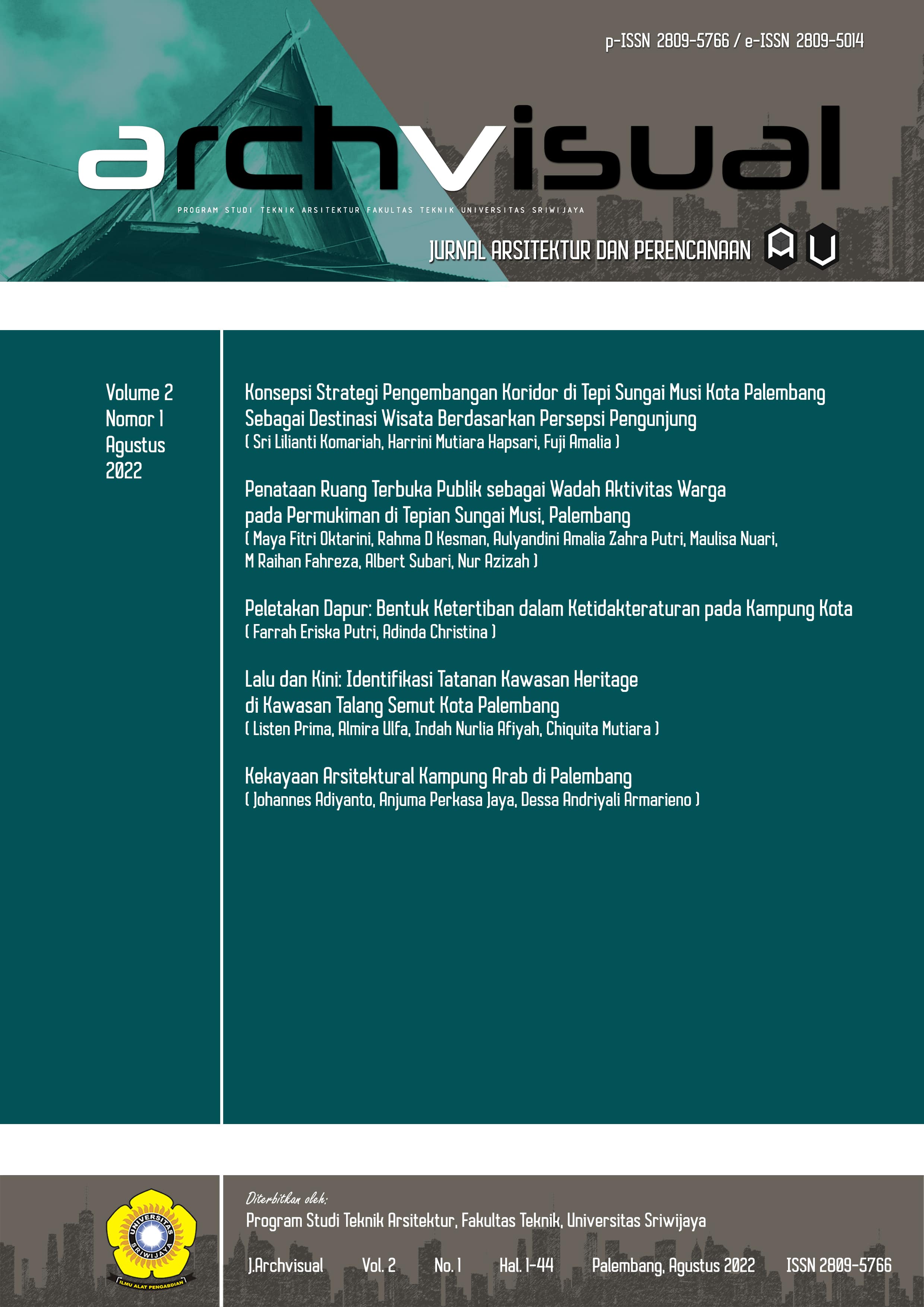Penataan Ruang Terbuka Publik sebagai Wadah Aktivitas Warga pada Permukiman di Tepian Sungai Musi, Palembang
Main Article Content
Abstract
The planning riverside area can be a solution for the provision of public open space. The planning should promote the special character of the landscape and the community’s social culture. Open spaces in dense settlements use for expansion of the cramped house for daily activities and socializing between residents. The research location is in a settlement around the Ampera Bridge in Palembang. This study aims to present an alternative riverbank open space design based on the specific of the physical conditions and activities of riverside settlement. Observation includes the number of types of users, activities, area, and facilities. The results showed that active points were found in seven open spaces. The intensity and type of activity is influenced by the area, panorama, and facilities. Access to the river is the most important element in designing open spaces on the banks of the river. Residents' activities are often related to rivers. The access will revive the use of open space as a link between the river and the daily activities of residents. The arrangement also needs to be equipped with additional facilities of the daily needs for the resident’s reason to visit open spaces.
Article Details
Section

This work is licensed under a Creative Commons Attribution-NonCommercial 4.0 International License.
How to Cite
References
Abidin, R., & Suryani, N (2020) Students’ Perceptions of 360 Degree Virtual Tour-Based Historical Learning About the Cultural Heritage Area of the Kapitan and Al-Munawar Villages in Palembang City. International Journal of Social Sciences and Management, vol. 7, no. 3, 105–112.
Ahern, J (1991) Planning for an Extensive Open Space System: Linking Landscape Structure and Function. Landscape and Urban Planning, vol. 21, no. 1, 131–145. https://doi.org/10.1016/0169-2046(91)90037-M
Askari, A. H., & Soltani, S (2019).Determinants of a Successful Public Open Space: The Case of Dataran Merdeka in the City Centre of Kuala Lumpur, Malaysia. Landscape Research, vol. 44, no. 2, 162–173
Costamagna, F., Lind, R., & Stjernström, O (2019) Livability of Urban Public Spaces in Northern Swedish Cities: The Case of Umeå. Planning Practice & Research, vol. 34, no. 2, 131–148, https://doi.org/10.1080/02697459.2018.1548215
Dietrich, U., & Kengyel, N (2016) What Makes a Public Open Space Liveable? 11th International Conference on Urban Regeneration and Sustainability (SC 2016), 12-14 July 2016 Alicante, Spain, 685–696
Elsawy, A. A., Ayad, H. M., & Saadallah, D (2019) Assessing Livability of Residential Streets – Case Study: El-Attarin, Alexandria, Egypt. Alexandria Engineering Journal, vol. 58, no. 2, 745–755, https://doi.org/10.1016/j.aej.2019.06.005
Fitri, M., Triyadi, S., & Harun, I. B (2017) A Topology of Residents’ Based on Preferences for sustainable Riparian Settlement in Palembang, Indonesia. MATEC Web of Conferences, 101, 05025.
Hernández, B., Hidalgo, M. C., & Ruiz, C (2020) Theoretical and methodological Aspects of Research on Place attachment. Place Attachment, 94–110
Lussetyowati, T., Sutriyono, E., Taqwa, R., & Fransiska, W (n.d.). Identification of Urban Soace of Riverside Settlement, Case Study: 3-4 Ulu Palembang, 9
Oktarini, M. F., Hidayat, H., Susanto, K., & Abilais, A.(2022) Bentuk Ruang Terbuka pada Permukiman Tepian Sungai Musi, Palembang, Archvisual: Jurnal Arsitektur Dan Perencanaan, vol. 2, no. 1, 17–24
Putra, H. W. S., Al Amin, M. B., & Ibrahim (2022) Typology and Characteristics of Slum Settlement in Wetland of Palembang City. In L. Yola, U. Nangkula, O. G. Ayegbusi, & M. Awang (Eds.), Sustainable Architecture and Building Environment, 151–160) Springer. https://doi.org/10.1007/978-981-16-2329-5_17
Sastika, A., & Yasir, A (2017) Karakteristik Permukiman di Tepian Sungai. Studi Kasus: Permukiman di Tepian Sungai Musi, Jurnal Koridor, vol. 8, no. 2, 83–88
Sharan, A (2016) A river and the Riverfront: Delhi’s Yamuna as an in-Between Space. City, Culture and Society, vol. 7, no. 4, 267–273 https://doi.org/10.1016/j.ccs.2014.12.001
Triyuly, W (2013) Pola perkembangan permukiman kampung Assegaf Palembang, Berkala Teknik, vol. 3, no. 2, 508–517
Widjajanti, R., & Wahyono, H (2018) Space Livability of Street Vendors in Simpang Lima Public Space, Semarang. IOP Conference Series: Earth and Environmental Science, vol. 123, no. 1, 012045. https://doi.org/10.1088/1755-1315/123/1/012045
Zhang, W., & Lawson, G (2009) Meeting and greeting: Activities in Public Outdoor Spaces Outside High-Density Urban Residential Communities, Urban Design International, vol. 14, no. 4, 207–214

